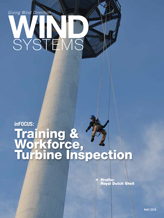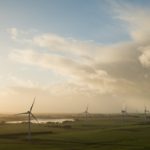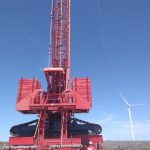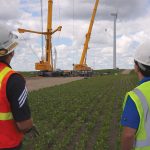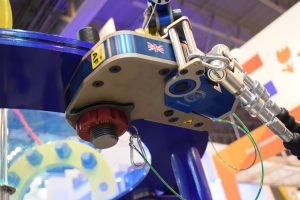As fleets age and the cost of wind-energy O&M rises, wind-farm owners and operators look far and wide for ways to achieve efficiency. In this article we look at the importance of the human factor and examine key challenges faced by companies and their employees. We look at how readily available advanced mobile and cloud-information technology can be a potent tool in helping wind technicians and their managers battle complexity and get better results while significantly lowering the cost of wind turbine O&M.
Wind is an abundant, affordable and scalable source of renewable energy. According to a report released by the U.S. Department of Energy, “Wind Vision: A New Era for Wind Power in the United States,” by 2050, wind energy in the U.S. alone has the potential to create 600,000 jobs and provide consumers with $149 billion in savings. Today’s wind turbines are not the prairie windmills of yesteryear. They are massive, highly sophisticated machines. A modern wind turbine has a whopping 8,000 components.

Wind-turbine fleets are aging and O&M costs are going up. According to IHS Markit, “the majority of installed wind-turbine equipment averages more than five years in age, and operations and maintenance (O&M) expenses cost the industry $3 billion to $4 billion annually (in the U.S.)” In fact, this increase in O&M costs is what’s driving significant growth potential for employment in the sector, making wind-energy technicians the fastest growing occupation.
According to the U.S. Bureau of Labor Statistics, the demand for these workers will double in the next seven years.
O&M costs associated with wind turbines are significant, making up on average, 20 percent to 25 percent of the total levelized cost per kWh produced over the lifetime of a turbine. In recent years, as fleets age, a good deal of attention has been given to methodologies and technologies that can help reduce wind-turbine O&M costs. Specifically, advances have been made in areas of predictive maintenance, condition monitoring systems, and even use of aerial drone technology for automated blade inspections. However, as is often the case, some of the more basic but perhaps less glamorous factors related to how wind companies enable O&M teams to organize, gather data, and communicate have been ignored. In this article we analyze the key challenges in these areas and how relatively inexpensive and easy-to-deploy information technology solutions can produce an outsized effect. We describe how these innovative solutions can boost the effectiveness and efficiency of wind-turbine inspections and O&M programs.
The Human Factor in Wind O&M
Maintaining wind turbines is hard work. Wind turbine O&M field work is physically demanding labor, requiring early hours, long drives over backroads, and 300-foot ladder climbs just to get to the office. Wind technicians and field personnel are under tremendous time pressure to complete jobs quickly and efficiently. With wind installations in remote areas and the move toward more offshore installations, the completeness and accuracy of site visits is becoming ever more important. The human factors involved in the operations therefore deserve special attention.
Battling Complexity
Wind-turbine inspectors and O&M personnel work remotely on complex equipment. The number of components and steps involved in maintenance routines can be mind-boggling. In this environment, lack of clear instructions and on-the-spot contextual information can lead to mistakes and less-than-optimal results or, worse yet, serious incidents or accidents.

Classroom training, on-the-job shadowing of more experienced personnel, and daily crew meetings are important tools for imparting knowledge and know-how to employees. However, work in wind energy is a classic example of how in today’s ever-growing complex world, the human performance factors can come into play in a major way. To take an example from the aviation world, where the cost of mistakes is rather high, even the most experienced pilots are required to follow detailed step-by-step checklists. Studies from the medical world similarly point out the power of checklists in preventing mistakes. In his highly acclaimed book “The Checklist Manifesto: How to Get Things Right ” author Atul Gawande says: “The modern world has given us stupendous know-how. Yet avoidable failures continue to plague us in health care, government, the law, the financial industry — in almost every realm of organized activity. And the reason is simple: The volume and complexity of knowledge today has exceeded our ability as individuals to properly deliver it to people — consistently, correctly, safely.”
With the rapid growth in demand for wind-turbine maintenance services and the corresponding demand for technicians, companies will be faced with hiring less-experienced resources.
Companies need to not only arm all employees with easily accessible instructions and information to do their job but do so within an accountable and trackable framework that ensures the steps are in fact followed.
Advances in mobile computing in the last decade and creation of flexible software platforms have made it possible to quickly create and provide clear, checklist-driven instructions to field personnel — even in remote areas where they may not have access to cellular or WiFi connectivity. Checklists can be set up to require mandatory completion of each item, addition of pictures, and annotations. Additionally, some of the more advanced software options allow embedding drawings, reference manuals, and how-to video clips right into the checklist, making these much more likely to be referenced and used.
Getting to Good and Great with Data
Wind-energy maintenance visits are costly. A one-day visit with three to five people can easily run in the multi-thousand dollar range when you factor in labor, tools, transportation, and, of course, wind-turbine downtime. With the shortage of resources, there is also the opportunity cost to consider. Crews that are visiting one wind farm are not available for other sites with perhaps more pressing maintenance tasks. It’s important to maximize the results from each trip. A key consideration is to ensure all necessary data is collected in the most complete and accurate manner while crews are onsite. Often this data can be critical to analysis back at the office and/or creation of client-facing reports that are required before invoicing for services. Repeat site trips as a result of crews leaving a wind farm without a complete set of data are significant contributors to the overall cost of O&M.

As mentioned above, checklists can be used to guide wind technicians to follow the correct procedural steps to perform a PM routine or to diagnose, fix, and verify a reactive maintenance task. Similar digital checklists can also be used to ensure a complete set of data is gathered while onsite.
Given how busy and time-pressured technicians are during a typical visit, wind-farm operators and service providers need to do all they can to reduce the fatigue and workload. Juggling notebooks, paper forms, spreadsheets, laptops, and cameras while wearing PPE and harnesses is exhausting and significantly slows down work. Reducing the number of devices and media can thus be hugely beneficial. With modern mobile devices and field apps, technicians can focus on their work steps on a single device. The mobile app guides them as to the steps to follow, list of data to collect including measurements, drop-down choices for standardized conditions of equipment, and prompts to capture multimedia and comments when warranted.
Capturing and Tracking Corrective Actions
During a typical visit, wind-turbine inspectors may notice numerous issues: a lubrication pot that’s nearly empty, corrosion that’s creeping up on a cooling fan housing, vibration emanating from a damaged blade, or a missing safety guard rail. All of these are examples of issues that need to be recorded and reported.
The complexity of the work combined with time constraints and work fatigue can conspire to have these observations fall through cracks, denying the team the opportunity to investigate and resolve them while the opportunity still exists. Study after study shows that major failures and tragic safety incidents are rarely due to a single factor but rather arise when multiple seemingly simple issues come together. Apart from the simple fact of recording an issue or corrective action, wind-farm operators need to pay attention to how well corrective actions are described, assigned, and tracked to resolution. With rudimentary tools such as paper notes and spreadsheets, descriptions of issues are often illegible or lack sufficient detail. Additionally, given the need for data re-entry, issues are not centralized in a unified database and can easily be overlooked.
Today’s mobile IT field technology makes it exceedingly easy for technicians to log corrective actions and observations the moment they are encountered. The technology can be used by technicians in an ad-hoc fashion and/or be set up to automatically prompt the technician to record a corrective action task when a failed condition is observed within a checklist. Pictures and even video clips can be recorded seamlessly and attached directly to tasks providing an accurate description of the issue to folks back at the office or subsequent crews. Given the cloud connectivity of many such tools, corrective actions are automatically transmitted to a centralized dashboard for management tracking and resolution by personnel.
Rapid Turnaround and Reporting
It is important to remember that wind-farm visits and turbine inspections are not done in a vacuum. Often one or more downstream business processes depend on the results of a site visit. For example, the inspections could be part of a due diligence study performed on behalf of a potential investor. Or, they may be part of a contractual preventive maintenance program offered to a wind-farm owner or may be part of a reactive maintenance trip to fix an issue and bring a turbine back online.

Regardless of the purpose, rapid turnaround of the inspection process and the ability to get eyes on reliable data evidencing and documenting the visit is crucial. Traditionally, given the remote location of wind farms, it can take days to receive this data when you combine the need for technicians to collect, tabulate, and package the data, complete with comments, notes, and pictures, into a comprehensive archive and ultimately transmit this to the office. In this space of time, management, engineering, and other reviewers back at the office are stalled when it comes to the status of work and ability to generate reports or certify the work as complete.
Bridging the time and space gap across field and office is a crucial area that can benefit wind-farm operators, owners, and service providers. Establishing a near-real time data pipeline and visibility into the status of work being performed cannot only ensure data is available for analysis, validation, and reporting right away, it can also stimulate collaborative problem-solving between field personnel and remote managers or subject matter experts. With advances in cloud and mobile communication, it is now possible to cost-effectively achieve this level of data synchronization and communication with personnel at wind farms.
Sourcing Raw Ingredients for Analysis
In recent years, a great deal of emphasis has been placed on the importance of predictive maintenance and use of advanced AI and machine learning algorithms for predicting when failures are likely to occur. The lifeblood of all such methodologies is copious amounts of data. Today’s modern wind turbines are increasingly equipped with a variety of sensors measuring temperature, wind speed, vibration, fluid quality, and other parameters that are recorded and made available via SCADA systems. While this data forms a valuable baseline, its utility in prediction can be greatly enhanced when combined with onsite human observations and measurements. In order for the human-generated data to successfully mesh with machine SCADA data, the former needs to be organized, standardized, and structured. Digitizing the technician data collection process using mobile technology makes it possible to achieve this goal. In this fashion, not only a single centralized body of data is available, but every data item is properly referenced to the correct wind turbine, component, and serial number. This data can then be correlated reliably with SCADA data for a powerful comprehensive picture of each asset and its subcomponents.
Attracting and Keeping Top Talent
Last but definitely not least, as we enter an era of mass-retirement (12,000 baby boomers retire every day in the U.S. alone — being replaced by the mobile, social-media native generation) and the demand doubles for wind-turbine technicians in the next seven years, wind-farm operators and service providers are increasingly searching for ways to recruit, train, and retain top talent.

Given the remote and often isolating nature of work in wind energy, mobile technologies that enable connectivity provide an important lifeline to employees. The ability for field employees to report what they see in a visible manner contributes to their engagement. Being able to essentially tell a story of what they encounter and having the opportunity to interact in real time with the rest of the team and management, provides them with the sense that they have a voice, and their contribution is noticed and appreciated.















